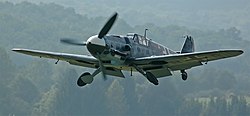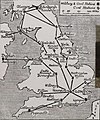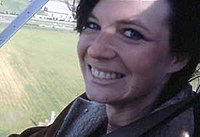Portal:Aviation
| Main page | Categories & Main topics |
|
Tasks and Projects |
The Aviation Portal

Aviation includes the activities surrounding mechanical flight and the aircraft industry. Aircraft includes fixed-wing and rotary-wing types, morphable wings, wing-less lifting bodies, as well as lighter-than-air aircraft such as hot air balloons and airships.
Aviation began in the 18th century with the development of the hot air balloon, an apparatus capable of atmospheric displacement through buoyancy. Clément Ader built the "Ader Éole" in France and made an uncontrolled, powered hop in 1890. This is the first powered aircraft, although it did not achieve controlled flight. Some of the most significant advancements in aviation technology came with the controlled gliding flying of Otto Lilienthal in 1896; then a large step in significance came with the construction of the first powered airplane by the Wright brothers in the early 1900s. Since that time, aviation has been technologically revolutionized by the introduction of the jet which permitted a major form of transport throughout the world. (Full article...)
Selected article
The word 'helicopter' is adapted from the French hélicoptère, coined by Gustave de Ponton d'Amecourt in 1861, which originates from the Greek helix/helik- (ἕλικ-) = 'spiral' or 'turning' and pteron (πτερόν) = 'wing'.
Helicopters were developed and built during the first half-century of flight, with some reaching limited production, but it was not until 1942 that a helicopter designed by Igor Sikorsky reached full-scale production, with 131 aircraft built. Though most earlier designs used more than one main rotor, it was the single main rotor with antitorque tail rotor configuration of this design that would come to be recognized worldwide as the helicopter. (Full article...)
Selected image

Did you know
...that the hyper engine was a hypothetical aircraft engine design meant to deliver 1 horsepower from 1 cubic inch of displacement? ...that the Cessna 165 aircraft was instrumental in the recovery of the Cessna Aircraft Company in the years following the Great Depression? ... that the Tony Jannus Award for distinguished achievement in commercial aviation is named for the pilot of the first scheduled commercial airline flight?
General images -
In the news
- May 29: Austrian Airlines cancels Moscow-bound flight after Russia refuses a reroute outside Belarusian airspace
- August 8: Passenger flight crashes upon landing at Calicut airport in India
- June 4: Power firm helicopter strikes cables, crashes near Fairfield, California
- January 29: Former basketball player Kobe Bryant dies in helicopter crash, aged 41
- January 13: Iran admits downing Ukrainian jet, cites 'human error'
- January 10: Fire erupts in parking structure at Sola Airport, Norway
- October 27: US announces restrictions on flying to Cuba
- October 3: World War II era plane crashes in Connecticut, US, killing at least seven
- September 10: Nevada prop plane crash near Las Vegas leaves two dead, three injured
- August 6: French inventor Franky Zapata successfully crosses English Channel on jet-powered hoverboard
Related portals
Associated Wikimedia
The following Wikimedia Foundation sister projects provide more on this subject:
-
Commons
Free media repository -
Wikibooks
Free textbooks and manuals -
Wikidata
Free knowledge base -
Wikinews
Free-content news -
Wikiquote
Collection of quotations -
Wikisource
Free-content library -
Wikiversity
Free learning tools -
Wikivoyage
Free travel guide -
Wiktionary
Dictionary and thesaurus
Selected biography
Despite her surname, Jeana Yeager is not related to Chuck Yeager, the first man to break the sound barrier in level flight.
Selected Aircraft

The Messerschmitt Bf 109 was a German World War II fighter aircraft designed by Willy Messerschmitt in the early 1930s. It was one of the first true modern fighters of the era, including such features as an all-metal monocoque construction, a closed canopy, and retractable landing gear. The Bf 109 was produced in greater quantities than any other fighter aircraft in history, with a total of 33,984 units produced up to April 1945. Fighter production totalled 47% of all German aircraft production, and the Bf 109 accounted for 57% of all German fighter types produced.
The Bf 109 was the backbone of the Luftwaffe fighter force in World War II, although it began to be partially replaced by the Focke-Wulf Fw 190 from 1941. The Bf 109 was the most successful fighter of World War II, shooting down more aircraft than any of its contemporaries. Originally conceived as an interceptor, it was later developed to fulfill multiple tasks, serving as bomber escort, fighter bomber, day-, night- all-weather fighter, bomber destroyer, ground-attack aircraft, and as reconnaissance aircraft.
The Bf 109 was flown by the three top-scoring fighter aces of World War II: Erich Hartmann, the top scoring fighter pilot of all time with 352 victories, Gerhard Barkhorn with 301 victories, and Günther Rall with 275 victories. All of them flew with Jagdgeschwader 52, a unit which exclusively flew the Bf 109 and was credited with over 10,000 victories, chiefly on the Eastern Front. Hartmann chose to fly the Bf 109 in combat throughout the war, despite being offered the use of the Me 262. Hans-Joachim Marseille, the highest scoring German ace in the North African Campaign, also scored all of his 158 victories flying the Bf 109, against Western Allied pilots.
- Span: 9.925 m (32 ft 6 in)
- Length: 8.95 m (29 ft 7 in)
- Height: 2.60 m (8 ft 2 in)
- Engine: 1× Daimler-Benz DB 605A-1 liquid-cooled inverted V12, 1,475 PS (1,455 hp, 1,085 kW)
- Cruising Speed: 590 km/h (365 mph) at 6,000 m (19,680 ft)
- First Flight: 28 May 1935
Today in Aviation
- 2013 – The United States Department of Defense grounds all 51 United States Air Force, United States Navy, and United States Marine Corps F-35 Lightning II aircraft after an inspection of a U.S. Air Force F-35A at Edwards Air Force Base, California, discovers a cracked engine blade.[1]
- 2011 – Christchurch International Airport is closed after a magnitude 6.3 earthquake rocks the city center, causing extensive damage, deaths and injuries.
- 2011 – Former Libyan Ambassador to India Ali Abd-al-Aziz al-Isawi confirms that Libyan Air Force jets have bombed civilians.[2]
- 2009 – Australian airline SkyAirWorld suspends operations pending a restructure of its business.
- 2007 – A UH-60 Black Hawk crashed in an area north of Baquba City. The helicopter went down in a clash between gunmen and U.S. troops.[3]
- 1996 – Launch: Space Shuttle Columbia STS-75 at 20:18:00 UTC. Mission highlights: Hubble Space Telescope servicing.
- 1995 – The CIA’s Corona reconnaissance satellite program, run in secret with help from the US Air Force from 1959 through 1972, is declassified. Corona satellites were launched aboard rockets, took photos of the Soviet Union and China, then parachuted back into the atmosphere where they would be retrieved in the air by specially equipped US Air Force C-119 Flying Boxcar transport planes.
- 1995 – Slingsby T-3A Firefly, 93-0555, N3092K, 'RA', of the 557th FTS, crashes when it fails to recover from a spin, killing instructor Capt. Dan Fischer, 29, and Cadet Mark Dostal, 20, of Moraga, California. Trainer made 17 tight spirals as it dropped one mile in 30 seconds before impacting ~50 miles E of the Air Force Academy in Colorado. This was the first of three Firefly fatal accidents before the type was withdrawn from operation and the surviving airframes scrapped.
- 1993 – First flight of the McDonnell Douglas MD-90
- 1987 – First flight of the Airbus A320
- 1986 – Launch: Spot-1 satellite, with 10 panchromatic and 20 m multispectral picture resolution capability. Withdrawn December 31, 1990.
- 1978 – Launch: OPS 5111 (also known as Navstar-1), first satellite in the Global Positioning System (GPS).
- 1975 – First flight of the Sukhoi Su-25, a Soviet single-seat, twin-engine jet aircraft designed to provide close air support.
- 1974 – An unemployed tire salesman named Samuel Byck attempts to hijack a Delta Air Lines DC-9 at Baltimore/Washington International Airport using a .22 caliber handgun and a suitcase filled with gasoline bombs. Byck’s objective – To crash the plane into the White House and assassinate President Richard Nixon. The plane never leaves the gate, though he does shoot and kill a police officer and one of the pilots and wounds the other pilot before being wounded by police and then committing suicide.
- 1974 – U. S. Navy Lieutenant, junior grade, Barbara Ann Allen is designated a naval aviator, becoming the first female aviator in the United States Armed Forces.
- 1973 – A ceasefire in Laos immediately ends all U. S. Air Force strikes there by tactical aircraft. B-52 Stratofortress strikes will end two months later.
- 1969 – The Mil V-12, Russian helicopter, lifted a payload of 31,030 kg to 2951 m (9,682 feet), breaking the records for maximum payload carried to 2000m.
- 1967 – 845 of the 173rd Airborne Brigade take part in Operation Junction City, the only paratrooper assault of the Vietnam War
- 1959 – Death of Robert B. C. Noorduyn, Dutch engineer, businessman, aircraft designer and manufacturer.
- 1959 – A US Navy McDonnell F2H-4 Banshee, 127614, of VAW-11, NAS North Island, California, crashes during bad weather en route to NAS Alameda, California, killing the pilot, Lt.(jg) James F. Wyley. Wreckage can still be found at the crash site in a rugged area of California's Santa Cruz Mountains at [37.26894,-122.13096], in the Saratoga Gap Open Space Preserve.
- 1958 – On the occasion of the departure of G/C Ralph Weston as RCAF Comox Commanding Officer, 407 Squadron had all 12 of its Lancasters in the air for a ceremonial flypast.
- 1955 – Fifth of 13 North American X-10s, GM-19311, c/n 5, on X-10 flight number 13, out of Edwards AFB, California, has supersonic flight aborted when afterburners fail. Automated landing fails when chute deploys during radio-controlled approach, causing the vehicle to plunge into the desert and be destroyed.
- 1954 – First flight of the Convair R3Y Tradewind - There is conflicting information in Wikipedia's own article about the R3Y stating in one place the first flight was 22 Feb and in another 25 Feb.
- 1952 – Birth of James Philip Bagian, M. D., P. E. American engineer and NASA scientific astronaut.
- 1952 – Second accident in three days for 816 Squadron RAN occurs when a Fairey Firefly carrying Sub Lieutenant Durrant Small and Observer J. G. Sharp crashes into the sea near Seven Mile Beach, New South Wales. Both Small and Sharp are killed.
- 1950 – AOn its 102nd flight, the USAF Northrop XF-89 Scorpion, 46-678, crashed on Rosecrans Avenue in Manhattan Beach, California after making a high-speed low pass for Air Force officials at Hawthorne Airport (Northrop Field). Right horizontal stabilizer peeled off, aircraft disintegrated, throwing pilot Charles Tucker clear, parachuted safely, but flight engineer Arthur Turton died in mishap. Aircraft impacted five miles (8 km) from factory, setting alight a Standard Oil below-ground storage tank. Cause was found to be high-frequency, low-amplitude aeroelastic flutter of both the vertical and horizontal stabilizers.
- 1944 – The U. S. Army Air Forces create the United States Strategic Air Forces in Europe.
- 1944 – (Overnight)—Japanese aircraft conduct four raids against ships of U. S. Navy Task Force 58 as they approach Truk Atoll, inflicting no damage.
- 1944 – Japanese resistance on Eniwetok ends.
- 1943 – Boeing 314, Pan American "Yankee Clipper", NC18603, c/n 1990, (U.S. Navy BuNo 48224), crashes into the Tagus River near Lisbon, while on approach to Portugal by way of the Azores. Caught in a storm, the flying boat hooked a wingtip in a turn while attempting an emergency landing. 25 of 39 on board die. Among those killed are actress Tamara Drasin and international journalist Ben Robertson, en route to his new job, chief of the New York Herald-Tribune's London bureau. Actress Jane Froman is seriously injured. Her story of survival will be made into the 1952 film "With a Song in My Heart" starring Susan Hayward.
- 1942 – Death of August von Parseval, German airship designer.
- 1942 – Air Marshal Arthur “Bomber” Harris was appointed Commander-in-Chief to the RAF Bomber Command.
- 1941 – Saro Lerwick flying boat, L7263, of 209 Squadron, piloted by Plt. Off. Fyfe, goes missing. Extensive air and sea searches turn up no trace, nor any of 14 on board, including Wing Commander Bainbridge. A new C.O., Wing Commander MacDermott, is appointed a few days later.
- 1938 – First flight of the Fleet 50 Freighter was a twin-engine biplane Canadian general utility aircraft.
- 1935 – Leland Andrews breaks Doolittle’s January record, completing a transcontinental transport flight in 11 hours 34 min.
- 1934 – First flight of the Fairey S.9/30, a British two-seat, single-engined biplane built to an Air Ministry call for a fleet reconnaissance aircraft. Although only one was built, it was the progenitor of the Fairey Swordfish.
- 1932 – During the Shanghai Incident, three Imperial Japanese Navy Nakajima A1 N2 fighters from the aircraft carrier Kaga score the first air-to-air kill in Japanese history, shooting down a Nationalist Chinese Boeing fighter piloted by an American volunteer.
- 1928 – Australian Bert Hinkler lands at Fanny Bay in Darwin, Australia after 11,000-mile solo flight from England. He is the first to make such a trip, setting four other new records – Longest solo flight, longest light plane flight, first nonstop flight from London to Rome and fastest journey from Britain to India.
- 1925 – First flight of the Gloster Gamecock, a British biplane fighter.
- 1925 – First flight of the de Havilland DH.60 Moth
- 1922 – Death of Dmitri Dmitrijewitsch Fjodorow, Soviet Aircraft designer.
- 1921 – The first coast to coast airmail flight was flown by Jack Knight in a De Havilland DH-4. The flight from San Francisco to Roosevelt Field, New York took 33 hours and 20 min.
- 1917 – The prototype Curtiss JN-4 (Can.) was accepted by the RFC Canada at Long Branch Aerodrome, near Toronto, Ontario.
- 1913 – French aviator Jules Védrines becomes the first pilot to fly over 100 mph, behind the controls of a Deperdussin Monocoque near Pau, France.
- 1912 – The Fokker Aviatik G. m. b. H. company is entered in the trade register at Berlin, Germany with a quoted capital of 20,000 marks. The company’s Holland-born founder, Anthony Herman Gerard Fokker, was brought up in Haarlem, the Netherlands and moved to Germany where he developed a passion for aviation before designing his first airplane – The Spider No. 1 – In late 1910.
- 1912 – Jules Vedrines becomes the first pilot to exceed 100 miles per hour (161 km/h). He makes his flight in a Deperdussin monoplane near Pau, France.
- 1900 – Birth of Paul Kollsman, American inventor who invented barometers and instruments for instrument flight in airplanes.
- 1899 – Birth of Ronald Malcolm Fletcher, British WWI observer/gunner ace in two-seater fighters in conjunction with his pilot, Lt. S. F. H. Thompson.
- 1899 – Birth of Joseph Marie Le Brix, French raid aviator.
- 1893 – Birth of Wolfgang Güttler, German WWI flying ace.
References
- ^ Associated Press, "Pentagon Grounds F-35 Fighter Fleet After Finding Crack in 1 Engine Blade," The Washington Post, February 23, 2013, p. A4.
- ^ "3 Libyan Diplomats Resign". The Hindu. India. 22 February 2011. Retrieved 10 April 2011.
- ^ Han Lin (2007-02-22). "9th U.S. helicopter crashes in Iraq". Xinhua. Retrieved 2010-02-17.
- Shortcuts to this page: Portal:Airplanes • P:AVIA





















































